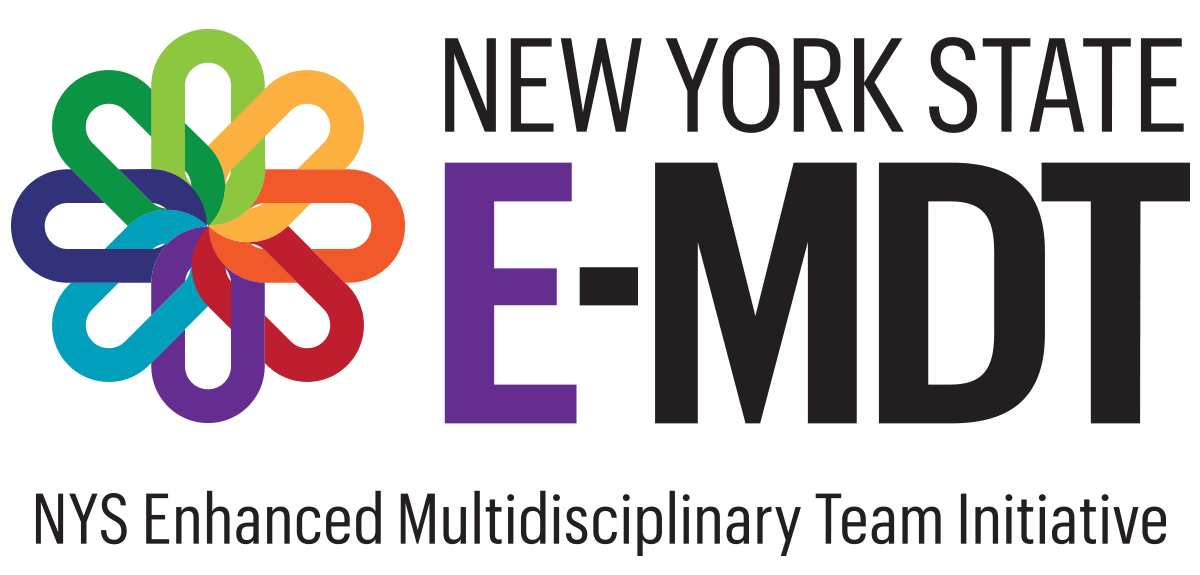What is an Elder Abuse E-MDT?
The primary purposes of E-MDTs are to intervene in cases of and stop all forms of elder abuse - financial exploitation, physical abuse, psychological abuse, sexual abuse, and neglect by others. Cases of elder abuse are reviewed, and multidisciplinary approaches are used as appropriate to address issues identified. The New York State E-MDTs are county-based, and typically have representation from Adult Protective Services, Office for the Aging, law enforcement, the district attorney’s office, and specialty service providers, including a forensic accountant, mental health professional, and civil legal attorney. There may be other team members depending on the unique community programs and services available in the county.
The E-MDT Coordinator is the designated leader of the E-MDT, responsible for administrative and clinical operations of the teams in their designated counties. The Coordinator will review every case referred and determine if the case can be resolved as a clinical case consultation or if the case requires presentation to the full E-MDT. Cases can be referred from any professional or agency, government, law enforcement, healthcare, finance, nonprofit, and other entities. To be eligible for a clinical case consultation or presentation to an E-MDT, a case must involve a county resident who is at least 60 years of age and suspected (or known) to be a victim of a crime.
E-MDTs meet regularly on a pre-determined schedule. Meetings include the presentation and discussion of new cases and/or review and follow-up of cases discussed at previous meetings. E-MDTs will develop and coordinate action plans as appropriate. Meetings may include training and discussion of procedural and team development matters.
The “Life” of an E-MDT Case
-
Referral
The E-MDT Coordinator will be contacted with a referral. Referrals can come from any professional or agency involved with assisting a victim age 60 or over.
-
Intake
The E-MDT Coordinator will contact the referral source by phone, email, or in person to discuss the case and complete an intake if the referral is appropriate for E-MDT review.
-
Notification
Once the E-MDT Coordinator has determined that the case is eligible and in need of presentation to the full E-MDT, they will reach out to other agencies to inquire about current or prior involvement.
The Coordinator will email E-MDT members confirming the monthly meeting and alerting them of a new case for the team to review.
-
Case Presentation
The referral source will present the case at the E-MDT meeting. The Coordinator works with the referral source to prepare a comprehensive case presentation.
-
Case Discussion
After the referral source presents the case, discussion is opened amongst the E-MDT members. The team members are encouraged to ask questions, request more information, and contribute to the delivery of potential interventions.
-
Recommendations Identified
Based on the discussion, a set of recommendations might be adopted that could include: resource and referral options, suggestions for the next steps, or coordination between agencies involved.
Any further discussion of the risks and benefits occurs at this point.
E-MDT members are given action items, if applicable.
-
Summary of Recommendations
The E-MDT Coordinator will summarize the recommendations and assignments adopted by the team. Goals, timeframes, and follow-up plans are identified by E-MDT members and the referral source.
-
Follow-Up
E-MDT members are responsible for following through on recommendations they have identified and\or accepted.
-
Report Back to the E-MDT
When needed, the original referral source may return to the E-MDT seeking additional input based on the outcome of previous team recommendations.
Fighting Elder Abuse: What is an E-MDT?
In April 2022, the New York State Office for the Aging interviewed Allison Granata, Assistant Director for E-MDT Initiatives at Lifespan of Greater Rochester, as part of their Five Questions series. Allison discussed how E-MDTs assist in fighting elder abuse across the state. Watch this interview below.

